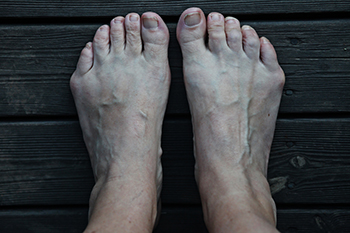
A tailor’s bunion, also known as a bunionette, is a painful bump that forms on the outside of the foot at the base of the little toe. It may appear red, swollen, or callused and often becomes irritated by tight or narrow shoes. The condition can feel sore or sharp when walking or wearing certain shoes. Causes include inherited foot structure, pressure from ill-fitting shoes, or abnormal foot mechanics. Symptoms may worsen over time if left untreated. A podiatrist can diagnose a tailor's bunion through a physical exam and imaging, such as X-rays, to assess the alignment of the toe and surrounding joints. Conservative treatment options include shoe modifications, padding, and orthotics to reduce pressure. Anti-inflammatory medications may be prescribed for pain relief. In more severe cases, surgery may be recommended to realign the toe and remove the bony prominence. It is suggested that you make an appointment with a podiatrist for proper diagnosis and personalized treatment.
If you are suffering from bunion pain, contact Daniel Mendoza, DPM of Nashville Podiatry. Our doctor can provide the care you need to keep you pain-free and on your feet.
What Is a Bunion?
Bunions are painful bony bumps that usually develop on the inside of the foot at the joint of the big toe. As the deformity increases over time, it may become painful to walk and wear shoes. Women are more likely to exacerbate existing bunions since they often wear tight, narrow shoes that shift their toes together. Bunion pain can be relieved by wearing wider shoes with enough room for the toes.
Causes
- Genetics – some people inherit feet that are more prone to bunion development
- Inflammatory Conditions - rheumatoid arthritis and polio may cause bunion development
Symptoms
- Redness and inflammation
- Pain and tenderness
- Callus or corns on the bump
- Restricted motion in the big toe
In order to diagnose your bunion, your podiatrist may ask about your medical history, symptoms, and general health. Your doctor might also order an x-ray to take a closer look at your feet. Nonsurgical treatment options include orthotics, padding, icing, changes in footwear, and medication. If nonsurgical treatments don’t alleviate your bunion pain, surgery may be necessary.
If you have any questions, please feel free to contact our office located in Hendersonville, TN . We offer the newest diagnostic and treatment technologies for all your foot care needs.
